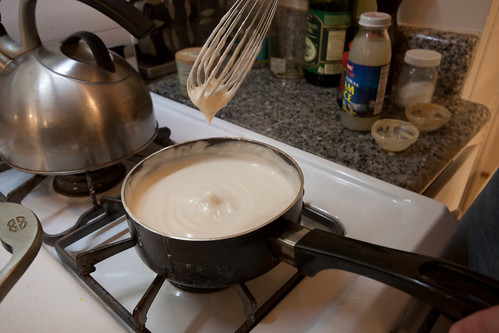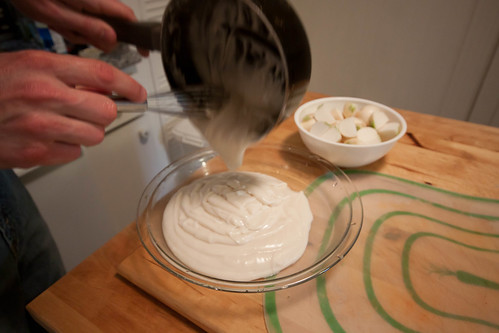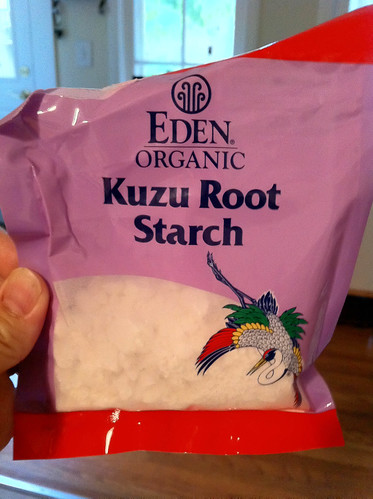How can a dish with no sugar in it be such a stunningly tasty dessert? We fell in love with a number of things while in Japan, one of them being a fantastic dish called Goma-dofu, or sesame dofu. It had a creamy, savory-nutty sweetness that was terribly addictive. Note that it’s not actually soy-based tofu though; it’s made of ground sesame seeds and kuzu starch, and makes for a great vegan dish. Kuzu (or Kudzu) is a perennial ornamental vine that’s a member of the pea family, and originally hails from Asia where its root starch is used primarily as a thickener for soups, stews, and sauces. In Japan it’s used in both savory and sweet treatments.
We ate a number of tasty goma dofu dishes while we were in Japan, and before we had even returned to the states I vowed that I would try to replicate it at home.
Procedure:
DD used this JustHungry Recipe, fairly simple because the base procedure without sauces or accompaniments just calls for 3 items: sesame seeds, kuzu and water. There are other variations that use different kinds of starches and some may even call for the addition of dashi, which is the version I’d like to try next. I also saw some beautiful black tahini paste at the Rainbow Grocery Coop that could go wonderfully in this recipe.
First you use a bit of water from the 2 cups allotted to dampen the kuzu starch granules and make a paste. I purchased pure tahini paste from Rainbow – the ingredient list is composed of just sesame seeds.
After adding the rest of the water, bring it over to the stove and stir in the tahini over medium heat. Note that traditional recipes call for grinding sesame seeds in a suribachi by hand, but I’m not a novice monk, nor did we have the time or inclination to go it old-school…so, tahini it was. Stir constantly until the mixture will clearly begin to thicken. In DD’s case it seems to have seized up all at once.
Once it thickened we poured the batch into a pie plate that had been dampened with water. We chilled for 2 hours and sampled the results. Traditional goma dofu accompaniment calls for some soy and a bit of wasabi or ginger. I was a little amazed that there was no sugar in the recipe, since whenever we consumed it in Japan, I often saved it for or it was served near the end of the meal, which made me think of it as a dessert dish. Initially I also urged DD to include a little sugar in the recipe, or opt for making a sweet sauce topping. I’m now glad I didn’t. We tasted it at first, without any additions. It had chilled long enough, and had a good texture, but it tasted completely bland and a wee bit bitter. We then poured on a bit of soy sauce and DD topped it off with a wee morsel of wasabi for each of us. What an amazing change these savoury condiments rendered! The dish instantly developed those familiar creamy-rich, sesame-sweet-nutty flavours we had come to love – changing its unadorned character completely! We ate it tonight again, after dinner, as goma dofu should be consumed within the first couple of days it’s made… still highly satisfying, quelling any other cravings for a sweet finish to a meal.
Where to Buy Kuzu
Kuzu is unfortunately not cheap. At the Haight Street Whole Foods, 100g or 3.5 oz. is $6.99 a packet; we used about ½ of it making one of JustHungry’s recipes (about 4-5 servings). At Rainbow, the same Eden Organic-brand packet was going for $8.99, but Rainbow also has it in the bulk foods section, which cuts the price down to around $5.79 for 3.5 oz. Eden Organic sells it online for $7.61. I also saw it available at Nijiya, though I didn’t check the price there.
Post-script:
In the Southeastern US, where it was initially introduced in the 1930s to help control soil erosion, kuzu has since become and deemed invasive by the US Dept of Agriculture. In short, it grew just too well. In ideal conditions, a kudzu vine can grow to around 60 feet every year. Vigorous and prolific, kuzu has been known to, when unchecked, totally take over a building, area or structure and even kill trees and other plants by wrapping itself completely around the organism, shutting out light and air. And yet, despite its reputation as the “mile a minute” vine, its leaves make nutritious protein-rich animal fodder, and its sturdy vines have been used by basket-makers and weavers; the fragrant flowers can be made into jelly, and of course, kuzu’s starchy roots produce the ingredient of the moment. If only more folks in the US could somehow develop a use for kuzu’s tasty products, we could perhaps turn an invasive weed into a source for things beneficial, profitable and wonderful.





Pingback: Ryori Ryokan Hanaoka | Memory & Desire()
Pingback: Nojo - new Izakaya in Hayes Valley | Memory & Desire()
Pingback: Takemura Yudofu Restaurant | Tabemasu()